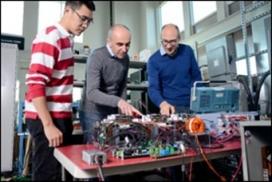Researchers Develop Electric Vehicle Rapid Chargers That Are Smaller, Cost Less Than Existing Models
Researchers at the NSF-funded Future Renewable Electric Energy Delivery and Management (FREEDM) Systems Engineering Research Center (ERC), headquartered at North Carolina State University, used wide bandgap (WBG) semiconductors to design an electric vehicle charger that is nine times smaller, weighs four times less, and will be lower cost than commercially-available systems.
The DC fast charger operates at distribution voltages, so it does not need ancillary equipment used by conventional systems. Instead of mounting a large electrical box on a concrete pad, the new charger can be mounted directly on utility poles, drastically reducing installation costs, and facilitating siting of the technology.
Wide bandgap (WBG) devices can operate at higher voltages, higher currents, higher temperatures, and higher switching frequencies than conventional Silicon power electronics. This allows electrical equipment like electric vehicle chargers, motor drives, and battery management systems to be smaller and more efficient.
The new EV charger design developed by the Center uses off-the-shelf Silicon Carbide (SiC) devices to rectify single-phase, medium voltage input to DC. It also uses a modular design to allow system scalability to higher voltage inputs, and greater power ratings.
Higher voltages and switching frequencies allow passive electrical components like capacitors and inductors to be much smaller without reductions in power ratings. This feature increases the power density of WBG-based devices. This project was funded through the Power America Manufacturing Innovation Institute, whose goal is to improve the performance and reliability of WBG semiconductors, and to make WBG technologies cost-competitive with silicon-based power electronics.



